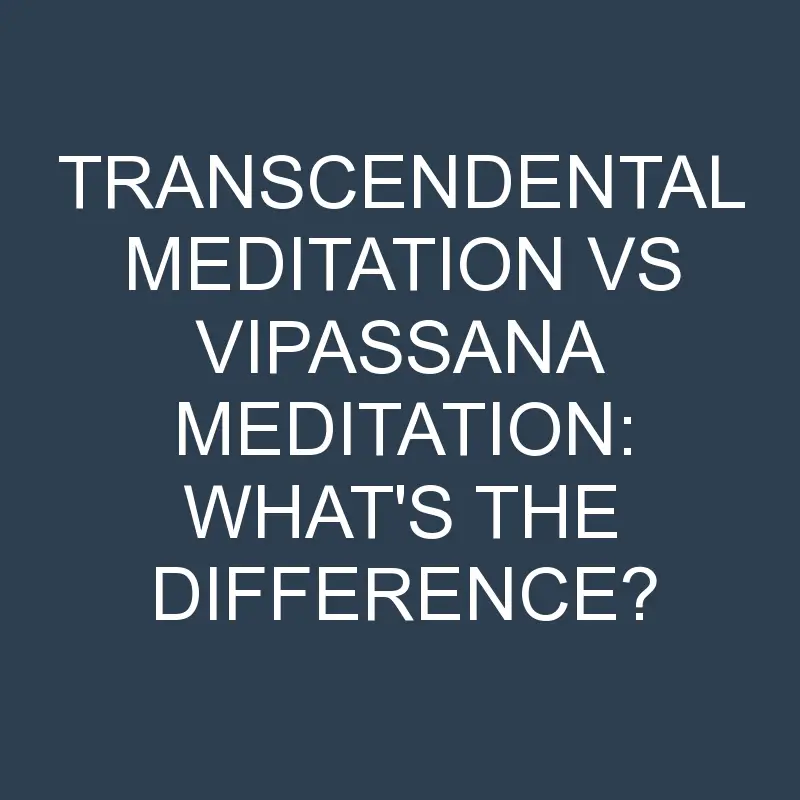If you’re interested in trying meditation but are unsure of where to start, you may be wondering what the difference is between transcendental meditation (TM) and vipassana meditation.
Both practices can be helpful in reducing stress and promoting relaxation, but they differ in some important ways. Read on to learn more about each type of meditation and how to decide which one is right for you.
Post Contents
Transcendental Meditation
When it comes to meditation, there are many different schools of thought and practices. Two popular methods are Transcendental Meditation (TM) and Vipassana Meditation. So, what’s the difference between these two approaches?
Transcendental Meditation is a form of mantra-based meditation that was popularized by Maharishi Mahesh Yogi in the 1950s. The goal of TM is to achieve a state of “transcendental consciousness” or ” pure awareness.”
This is done by repeating a mantra or sound (such as “om”) while sitting with eyes closed and focusing on the breath.
Vipassana Meditation, on the other hand, is a form of mindfulness meditation that was taught by the Buddha himself.
The goal of Vipassana is to gain insights into the true nature of reality and to experience liberation from suffering. This is done through observing the breath and being aware of thoughts, emotions, and sensations in the body.
So, which one is right for you? That really depends on your personal goals and preferences. If you’re looking for a more spiritually-oriented practice that can lead to deeper insights, then Vipassana may be a better choice. If you’re
Vipassana Meditation
There are a few key differences between Vipassana meditation and Transcendental Meditation (TM). For starters, Vipassana is an ancient Buddhist technique that’s been around for centuries, while TM is a more modern form of meditation that was developed in the 1950s by Maharishi Mahesh Yogi.
Vipassana is also a bit more hands-on than TM; during Vipassana meditation, practitioners focus on their breath and bodily sensations in order to develop a deeper awareness of the present moment. This can be done through mindfulness exercises, such as paying attention to the sensations of breathing or walking.
Another key difference is that Vipassana is typically done in silence, while TM includes the use of a mantra or sacred word that’s repeated during meditation. And finally, while there are many different schools of thought when it comes to Vipassana meditation, there’s only one organization that teaches TM.
The Different Types of Meditation
When it comes to meditation, there are many different ways to go about it. You may have heard of popular methods like transcendental meditation or vipassana meditation, but what exactly is the difference?
Transcendental meditation is a form of mantra-based meditation, where you focus on a particular word or phrase to help still the mind. This type of meditation can be practiced for just a few minutes at a time, making it perfect for busy people who want to fit in some mindfulness practice.
Vipassana meditation, on the other hand, is a form of Insight or mindfulness meditation. This means that rather than focusing on a mantra, you instead focus on observing your thoughts and feelings without judgment.
This can help you to become more aware of your thought patterns and eventually learn to let go of negative thoughts and emotions.
So which type of meditation is right for you? If you’re looking for something quick and easy to fit into your day, transcendental meditation may be the way to go.
However, if you’re seeking deeper self-awareness and insight, vipassana meditation may be more beneficial. Ultimately, the best way to find out is to try both methods and see which one works
Pros and Cons of Transcendental Meditation and Vipassana Meditation
There are many different types of meditation, and it can be difficult to choose the right one for you. Transcendental Meditation (TM) and Vipassana Meditation are two of the most popular methods. But what’s the difference between them?
Transcendental Meditation is a form of mantra meditation. You repeat a mantra (a word or phrase) over and over again to help you focus and reach a state of deep relaxation.
Vipassana Meditation is a form of mindfulness meditation. You focus on your breath and bodily sensations to become more aware of the present moment.
Both TM and Vipassana have their pros and cons. Some people find TM to be very relaxing and say it helps them reduce stress and anxiety. Others find that it’s difficult to stick with the practice, or that they don’t feel any different after doing it.
Vipassana can be challenging at first, but many people find it to be more beneficial in the long run. It can help you become more aware of your thoughts and emotions, and learn to let them go. It can also be helpful in dealing with pain, both physical and emotional.
Which One Should You Choose?
When it comes to choosing between Transcendental Meditation (TM) and Vipassana Meditation, it really depends on what you’re looking for in a meditation practice. If you’re simply looking for a way to relax and de-stress, then TM might be a good choice for you.
However, if you’re looking for a more profound meditative experience that can help you develop greater self-awareness and insight, then Vipassana might be a better option.
Conclusion
Although both Vipassana and Transcendental Meditation are effective in reducing stress and promoting inner peace, they are two very different techniques.
Vipassana is a form of mindfulness meditation that requires the observer to focus on their breath and the sensations in their body.
Transcendental Meditation, on the other hand, involves the use of a mantra or word to focus on during meditation. While both can be beneficial, it’s important to choose the one that’s right for you so that you can get the most out of your practice.
